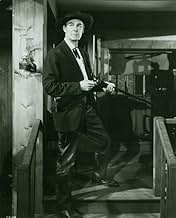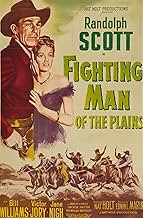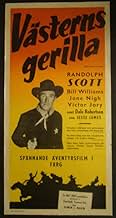Former bandit Jim Dancer becomes marshal of a Kansas town and cleans up the criminal element--with help from an old pal, Jesse James.Former bandit Jim Dancer becomes marshal of a Kansas town and cleans up the criminal element--with help from an old pal, Jesse James.Former bandit Jim Dancer becomes marshal of a Kansas town and cleans up the criminal element--with help from an old pal, Jesse James.
Featured reviews
In Fighting Man of the Plains Randolph Scott is a former member of Quantrill's Raiders who kills Barry Kelley's brother during the Civil War and Kelley is hot to get him. He privately hires the Pleasanton (Pinkerton) Detective Agency to track him down. Pleasanton man James Millican does succeed in capturing Scott after several years.
But a funny thing happens on the way back. Millican gets himself killed and Scott takes his identity. As a Pleasanton Man with law enforcement experience and being fast on the draw in any event, he's a natural to bring some law and order to the new trail town of Lanyerd, Kansas. Of course Randy gets himself hip deep in the various political factions and even runs across his old enemy, Barry Kelley.
It's a rather complex situation, but the writers did come up with an interesting resolution of the plot for Randy. It does involve Scott having good friends in low places.
Fighting Man of the Plains was the first film where Dale Robertson got noticed and Dale plays real life Quantrill veteran Jesse James. You could tell that Dale was going to have a substantial career.
Best performance in the film however without a doubt is that of Bill Williams of young on the prod gunfighter in Kelley's employ. He proves a bit too much for Kelley to handle.
Victor Jory appeared in many post war Randolph Scott films usually as a bad guy. It was unusual to see him as Scott's friend in this film. I also enjoyed Rhys Williams as the moneygrubbing justice of the peace.
Fighting Man of the Plains is one of Randolph Scott's better post World War II westerns. Don't miss it if broadcast again.
But a funny thing happens on the way back. Millican gets himself killed and Scott takes his identity. As a Pleasanton Man with law enforcement experience and being fast on the draw in any event, he's a natural to bring some law and order to the new trail town of Lanyerd, Kansas. Of course Randy gets himself hip deep in the various political factions and even runs across his old enemy, Barry Kelley.
It's a rather complex situation, but the writers did come up with an interesting resolution of the plot for Randy. It does involve Scott having good friends in low places.
Fighting Man of the Plains was the first film where Dale Robertson got noticed and Dale plays real life Quantrill veteran Jesse James. You could tell that Dale was going to have a substantial career.
Best performance in the film however without a doubt is that of Bill Williams of young on the prod gunfighter in Kelley's employ. He proves a bit too much for Kelley to handle.
Victor Jory appeared in many post war Randolph Scott films usually as a bad guy. It was unusual to see him as Scott's friend in this film. I also enjoyed Rhys Williams as the moneygrubbing justice of the peace.
Fighting Man of the Plains is one of Randolph Scott's better post World War II westerns. Don't miss it if broadcast again.
Directed by Edwin L. Marin and written by Frank Gruber, Fighting Man of the Plains stars Randolph Scott, Victor Jory and Jane Nigh. Music is by Paul Sawtell and cinematography by Fred Jackman Jr.
A solid and sturdy Marin and Scott Oater that finds Scott as an ex Quantrill raider assuming the identity of a dead detective in a post Civil War Lanyard, Kansas. Proving himself as a fellow made of stern stuff, he's quickly appointed Marshal and begins to clean up the town, but his past is sure to catch up with him...
Without breaking any new ground this still manages to get the key ingredients right in the name of entertainment. The script is sharp, the performances equally so (Jory is excellent), and Marin being the good old pro that he was, pushes things along at a good clip.
There's a lot going on in Lanyard, with various underhand plottings and a few vengeful motivations. While of course there's some simmering passion waiting to explode. The many key characterisations are richly born out, the action healthy, and there's even a couple of surprises along the way to keep the plotting interesting.
A couple of errors out there in the intranet universe need correcting. Some have it that Dale Robertson as Jesse James plays a big part in the cleaning up of Lanyard (yes Jesse is kind of a good bad guy here), but he doesn't as he's barely in it, but he does have a key scene to play in pics finale. So fans of Robertson, in what is believed to be his first credited role, should take that on board.
Secondly. I read a review that states Jory's Dave Oldham character is one of the shifty villains of the piece! He really isn't, he's firmly a friend and ally to Jim Dancer (AKA: Marshal Cummings), and it is he who is the one helping to clean up Lanyard. Another thing of note, filmed in Cinecolor, there seems to only be black and white prints of the movie available to view? Which is actually OK as the print I saw had that late 40s noirish vibe to the photography, but you would like to have the option of seeing the colour print for sure. 7/10
A solid and sturdy Marin and Scott Oater that finds Scott as an ex Quantrill raider assuming the identity of a dead detective in a post Civil War Lanyard, Kansas. Proving himself as a fellow made of stern stuff, he's quickly appointed Marshal and begins to clean up the town, but his past is sure to catch up with him...
Without breaking any new ground this still manages to get the key ingredients right in the name of entertainment. The script is sharp, the performances equally so (Jory is excellent), and Marin being the good old pro that he was, pushes things along at a good clip.
There's a lot going on in Lanyard, with various underhand plottings and a few vengeful motivations. While of course there's some simmering passion waiting to explode. The many key characterisations are richly born out, the action healthy, and there's even a couple of surprises along the way to keep the plotting interesting.
A couple of errors out there in the intranet universe need correcting. Some have it that Dale Robertson as Jesse James plays a big part in the cleaning up of Lanyard (yes Jesse is kind of a good bad guy here), but he doesn't as he's barely in it, but he does have a key scene to play in pics finale. So fans of Robertson, in what is believed to be his first credited role, should take that on board.
Secondly. I read a review that states Jory's Dave Oldham character is one of the shifty villains of the piece! He really isn't, he's firmly a friend and ally to Jim Dancer (AKA: Marshal Cummings), and it is he who is the one helping to clean up Lanyard. Another thing of note, filmed in Cinecolor, there seems to only be black and white prints of the movie available to view? Which is actually OK as the print I saw had that late 40s noirish vibe to the photography, but you would like to have the option of seeing the colour print for sure. 7/10
When you have Randolph Scott, you don't need much else, but "Fighting Man of the Plains" has everything.
Frank Gruber was a darn good writer of often very gritty stories. He wrote more than one story about Jesse James, a character who figures in this movie, too.
There is a rough realism in his stories, and that has translated beautifully in this film, thanks in part to Gruber's also writing the screenplay, and thanks to excellent directing by Edwin L. Marin, and thanks especially to a superlative cast.
One mark of a well-written and -directed film is the realism of the interaction of minor characters.
Another mark of a great movie is the number of speaking and participating characters, even with relatively small parts.
In "Fighting Man of the Plains," watch the anonymous characters, such as the blacksmith who's asked for directions, and the bartender who passes on messages and serves meals. In lesser films, they might get to nod or maybe point, but in a great film, such as this one, they speak and participate in what's going on.
Look for, for example, the great John Hamilton, and the great Paul Fix as a sleazy, vile character. Watch, too, for such greats as Lou Nova and Kermit Maynard. And not one of them gets screen credit! This is a great movie, extremely well done, and I urge you to see it.
Frank Gruber was a darn good writer of often very gritty stories. He wrote more than one story about Jesse James, a character who figures in this movie, too.
There is a rough realism in his stories, and that has translated beautifully in this film, thanks in part to Gruber's also writing the screenplay, and thanks to excellent directing by Edwin L. Marin, and thanks especially to a superlative cast.
One mark of a well-written and -directed film is the realism of the interaction of minor characters.
Another mark of a great movie is the number of speaking and participating characters, even with relatively small parts.
In "Fighting Man of the Plains," watch the anonymous characters, such as the blacksmith who's asked for directions, and the bartender who passes on messages and serves meals. In lesser films, they might get to nod or maybe point, but in a great film, such as this one, they speak and participate in what's going on.
Look for, for example, the great John Hamilton, and the great Paul Fix as a sleazy, vile character. Watch, too, for such greats as Lou Nova and Kermit Maynard. And not one of them gets screen credit! This is a great movie, extremely well done, and I urge you to see it.
If you can set aside the implicit CSA sympathies (Quantrell's Lawrence pre-dawn ambush/massacre was "just war"), this is a solid, quick oater.
A little more complicated than most, greed, skullduggery, honor, betrayals, loyalties, and gun play (not to Peckinpah levels, but enough) abound here.
The script is tight and never lags. The acting and direction are top notch - Paul Fix's turn as Yancy, for example, could easily have slid to caricature but never does. Most of the men characters have some surprises and three-dimensionality to them. Unfortunately the women characters are strictly two-dimensional.
"Fighting Man of the Plains" has its flaws - the redeemable outlaw's past is whitewashed, Jim Dancer would never be so slow to reach his weapon (except as needed to advance the plot) and, as mentioned above, the women are cliché. Still, overall, it is 90 minutes well spent.
A little more complicated than most, greed, skullduggery, honor, betrayals, loyalties, and gun play (not to Peckinpah levels, but enough) abound here.
The script is tight and never lags. The acting and direction are top notch - Paul Fix's turn as Yancy, for example, could easily have slid to caricature but never does. Most of the men characters have some surprises and three-dimensionality to them. Unfortunately the women characters are strictly two-dimensional.
"Fighting Man of the Plains" has its flaws - the redeemable outlaw's past is whitewashed, Jim Dancer would never be so slow to reach his weapon (except as needed to advance the plot) and, as mentioned above, the women are cliché. Still, overall, it is 90 minutes well spent.
After a fast start, this western settles into what amounts to a plot-heavy gab fest. I'm afraid fans expecting hard-riding, fast-shooting, or scenic horizons, are going to be disappointed. Not that everything is downside. No western with the great Randy Scott can be overlooked; also, perennial bad guy Victor Jory gets to essay a good guy, for a change. And, I really like Bill Williams as a boyishly unlikely gunsel. Then add pudgy, squinty-eyed Barry Kelley as the lead black hat, and it's a fine cast.
Too bad indie producer Nat Holt apparently spent everything on casting since it left him little for filming outside of studio sets. This results in a basically 'indoor' western with some action in the streets. Maybe that's the result of adapting Gruber's novel to the screen and leaving little out. So you may need a scorecard to keep up with all the characters and plot developments.
One thing to notice— how county officials are really being shown as in on the graft. I love that scene where justice of the peace (Williams) gouges penalty money out of anyone who dares speak up and then splits it up with his cronies. That's certainly no western cliché. All in all, the movie's long on complex story but short on traditional outdoor visuals. Still, even here, no one looks more the western hero than the iron-jawed Scott.
Too bad indie producer Nat Holt apparently spent everything on casting since it left him little for filming outside of studio sets. This results in a basically 'indoor' western with some action in the streets. Maybe that's the result of adapting Gruber's novel to the screen and leaving little out. So you may need a scorecard to keep up with all the characters and plot developments.
One thing to notice— how county officials are really being shown as in on the graft. I love that scene where justice of the peace (Williams) gouges penalty money out of anyone who dares speak up and then splits it up with his cronies. That's certainly no western cliché. All in all, the movie's long on complex story but short on traditional outdoor visuals. Still, even here, no one looks more the western hero than the iron-jawed Scott.
Did you know
- TriviaJames Millican portrays a private detective who arrests Randolph Scott, who is playing a former member of Quantrell's Raiders. In The Stranger Wore a Gun (1953), Millican plays Quantrell and once again, Scott is one of his former Raiders.
- Crazy creditsOpening credits prologue:
The vast plains of the American West proved a barrier so formidable that the westward march of civilization faltered before it for more than a decade. Yet Civilization must move on and the Great Plains were finally conquered. This is the story of one of these builders of the West ... Jim Dancer, bad man, outlaw ..... Fighting man of the plains.
During the desperate days of the Civil War-August 21, 1863,- Quantrell's raid on Lawrence, Kansas.
The bloody war between the states finally came to an end, but on the border the hatreds had been too great. Men continued to ride and fight and die. The name of Quantrell was heard no more, but new names were whispered, names of men who had ridden with Quantrell and were now outlaws.
1868 ARCH CLEMENTS 1869 THE YOUNGER BROTHERS 1870 JESSE JAMES 1871 JIM DANCER 1872 -
- ConnectionsReferenced in Unguarded Moment (1951)
Details
- Release date
- Country of origin
- Language
- Also known as
- Die Stadt der rauhen Männer
- Filming locations
- Production company
- See more company credits at IMDbPro
- Runtime1 hour 34 minutes
- Aspect ratio
- 1.37 : 1
Contribute to this page
Suggest an edit or add missing content

Top Gap
By what name was Fighting Man of the Plains (1949) officially released in India in English?
Answer






































